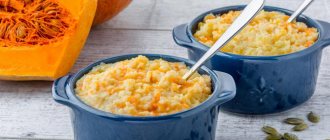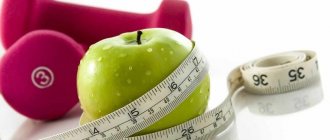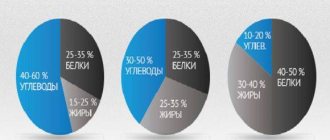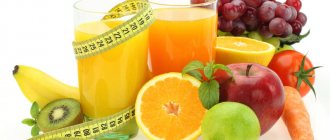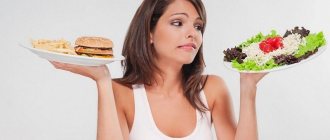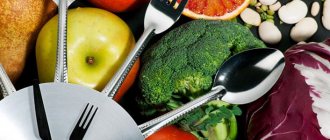A balanced diet for weight loss is required mainly by those women and men who dream of losing extra pounds. It allows you to achieve the long-awaited result without psychological costs. This state of affairs is important for every person struggling with excess weight, because the stress experienced in the process of dieting does not go away without leaving a trace.
Sample diet menu for a week
When using a low-calorie menu, you need to eat 5-6 times a day, in small portions , the weight of which does not exceed 200-250g.
First you need to use a kitchen scale, then you will learn how to determine the weight of portions by eye. Low-calorie diet for a week menu minus 5 kg (for people with very high weight).
1
The first day:
- Breakfast: rice porridge, boil 3-4 tablespoons, add a little low-fat milk. You can add a handful of raisins, dried fruits;
- Second breakfast: grated apple;
- Lunch: chicken soup, cabbage salad;
- Afternoon snack: kefir 1-2%;
- Dinner: baked fish, tomato and cucumber salad.
2
Second day:
- Breakfast: omelet of one yolk and two whites with low-fat milk;
- Second breakfast: grated carrots;
- Lunch: boiled chicken, cucumber and herb salad;
- Afternoon snack: tomato juice;
- Dinner: beef meatballs, lettuce with olive oil.
3
Day three:
- Breakfast: low-fat cottage cheese with chopped orange;
- Second breakfast: baked apple;
- Lunch: stewed vegetables (carrots, cabbage, onions, herbs, zucchini, eggplant, pumpkin, whatever is available) with the addition of minced chicken;
- Afternoon snack: orange;
- Dinner: stewed fish, green pea and herb salad.
4
Day four:
- Breakfast: oatmeal with hot low-fat milk and berries;
- Second breakfast: baked or fresh pear;
- Lunch: vegetarian soup, boiled turkey, cauliflower salad with herbs and olive oil;
- Afternoon snack: kefir with berries, can be whipped in a blender;
- Dinner: boiled veal, grilled vegetables: tomatoes, carrots, onions, zucchini.
5
Day five:
- Breakfast: buckwheat porridge with low-fat milk and a little butter;
- Second breakfast: grapefruit;
- Lunch: chicken cutlets, salad of Chinese cabbage, herbs and fresh cucumbers;
- Afternoon snack: apple juice;
- Dinner: salmon steak or salmon, tomatoes.
6
Day six:
- Breakfast: millet porridge with milk, you can add some dried fruit;
- Second breakfast: low-fat yogurt without additives;
- Lunch: soup with veal meatballs, vegetable salad;
- Afternoon snack: bifidokefir with fresh berries;
- Dinner: two boiled eggs, cucumber salad, greens.
7
Day seven:
- Breakfast: cottage cheese casserole with one raw egg and chopped fruits or berries;
- Second breakfast: grated apple;
- Lunch: boiled or baked chicken breast, stewed vegetables (cabbage, carrots, zucchini, onions, peas, tomatoes);
- Afternoon snack: low-fat fermented baked milk;
- Dinner: boiled turkey, two tomatoes, two cucumbers.
Having understood the basic principle of this diet , it is not difficult to select products yourself. You can choose your favorite ones that you personally like and cook them more often than others. In addition to the main menu, you need to supplement your diet with weak tea or coffee without sugar . You can add low-fat milk. The total daily calorie content should not exceed 1200 kcal. Also pay attention to the 1200 kcal diet, its principles will also be useful to you.

In order for weight loss on a low-calorie diet to be successful, you need to know which low-calorie foods should form its basis. In the table you can find a list of products that can be used in the low-calorie diet menu . The table is convenient to use when choosing side dishes from vegetable dishes for protein dishes.
What is a balanced diet
A balanced diet (BN) is a set of healthy nutrients, designed for one or another body weight, which contributes not only to the loss of extra pounds, but also to the improvement of the entire body. The SP is observed according to several principles.
Firstly, the number of calories received is reduced to a minimum, and nutrients received to a maximum. This happens by reducing the consumption of fat-containing foods.
Secondly, the body, due to a calorie deficit, speeds up its metabolism, thereby using up its own fat resources.
Attention! It is recommended to eat berries and fruits before 15:00, raw vegetables - before 17:00, otherwise their consumption will have a detrimental effect on the digestive system. An exception may be stewed or boiled vegetables.
A balanced diet is:
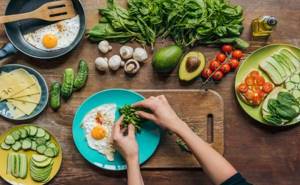
- Accelerated metabolism (active metabolism). It is an effective way to lose excess weight and build muscle mass (the condition will be properly selected exercises).
- The energy value of calories in the diet is selected so that the body spends energy from the inside, but at the same time does not feel an energy deficit.
- The regimen is in the form of fractional meals, divided into six daily portions. This approach allows you not to feel hungry, but at the same time not to overeat due to small portions. The last meal should be no later than 19.00. It is allowed, an hour before bedtime, to satisfy your hunger with a glass of kefir.
- Balance of proteins, fats, carbohydrates (B/F/U). Compliance with proportions in order to improve the health of the body will be as follows: B2/G1/U2. With a balanced diet, designed not for weight loss, but for controlling your weight, the formula will be different: B1/W1/U4. Fats of animal origin should be replaced with vegetable ones, and carbohydrates should be exclusively “long-term”.
- Cooking method. Not only excess body volume, but also health in general depends on this point. You will have to exclude fried, fatty, smoked, salty foods, as well as fast carbohydrates in the form of confectionery, chocolate and fast food products.
- Eating according to a person’s biorhythmic characteristics. Given this approach, emphasis should be placed on the rules established by nutritionists: breakfast should be eaten by a person no later than the first hour from his morning awakening; lunch should be divided into two stages, one of which will include soups and meat, and the other, main courses; be sure to have afternoon snacks several times a day; have dinner no later than three hours before going to bed.
- Drinking plenty of water throughout the day. It helps cleanse the body of toxins, better digestion of food, weight loss, and activation of metabolism.
- Limiting sugar and salt, which can retain water at the cellular level, preventing you from getting rid of extra pounds.
Calorie table for low-calorie foods
| Product category | Product Name | Calorie content per 100g | Product category | Product Name | Calorie content per 100g |
| Vegetables | broccoli | 33 | Meat (protein) | beef | 187-144 |
| carrot | 35 | veal | 90 | ||
| chilli | 20 | horsemeat | 143 | ||
| artichoke | 40 | lamb | 191 | ||
| cauliflower | 30 | rabbit | 199 | ||
| kohlrabi | 36 | beef liver | 98 | ||
| cucumbers | 15 | veal tongue | 163 | ||
| tomatoes | 23 | beef sausage | 165 | ||
| zucchini | 23 | chickens | 159 | ||
| eggplant | 24 | chicken category 1 | 238 | ||
| pumpkin | 28 | chicken category 2 | 159 | ||
| spinach | 22 | turkey | 197 | ||
| celery | 21 | chicken liver | 139 | ||
| radish, green onion | 19 | chicken heart | 158 | ||
| lettuce | 12 | chicken eggs | 157 | ||
| asparagus | 20 | egg white | 44 | ||
| greenery | 13 | egg yolk | 64 | ||
| bulb onions | 41 | quail eggs | 168 |
| Product category | Product Name | Calorie content per 100g | Product category | Product Name | Calorie content per 100g |
| Fish and seafood (protein) | fruit juice cabbage | 5 | Milk and dairy products (protein) | cow's milk | 62 |
| squid | 75 | milk n/w | 35 | ||
| shrimps | 83 | goat milk | 67 | ||
| crabs | 69 | kefir | 31-59 | ||
| mussels | 77 | yogurt | 52-112 | ||
| pollock | 69 | cottage cheese n/w | 86 | ||
| flounder | 87 | cottage cheese 10% | 170 | ||
| sea bass | 117 | Ryazhenka | 40-85 | ||
| tuna | 101 | cream 10% | 115 | ||
| cod | 75 | sheep milk | 107 | ||
| blue whiting | 72 | serum | 25 | ||
| mackerel | 153 | buttermilk | 40 | ||
| icy | 74 | grain cottage cheese | 105 | ||
| herring | 121 | sour cream 10% | 115 | ||
| Argentina | 88 | sour cream 15% | 160 | ||
| sprat | 137 | chocolate milk | 81 | ||
| hake | 86 | drinking yogurt | 82 | ||
| oysters | 72 | "Activia" | 104 |
| Product category | Product Name | Calorie content per 100g | Product category | Product Name | Calorie content per 100g |
| Fruits | apples | 48 | Mushrooms (protein) | white dried | 34 |
| pears | 42 | boletus | 20 | ||
| plums | 43 | boletus | 22 | ||
| grape | 69 | Honey mushrooms, saffron milk caps | 22 | ||
| Peach, apricot | 45 | Chanterelles, boletus | 19 | ||
| quince | 48 | Russula, milk mushroom | 18 | ||
| cherry | 52 | Champignon | 27 | ||
| Grapefruit, melon | 35 | nigella | 9 | ||
| 35 | Berries | blueberry | 39 | ||
| mandarin | 38 | strawberries | 41 | ||
| a pineapple | 52 | cranberry | 29 | ||
| lemon | 34 | blueberry | 40 | ||
| banana | 96 | rose hip | 101 | ||
| kiwi | 47 | currant | 39-43 | ||
| persimmon | 67 | raspberries | 46 | ||
| figs | 54 | cowberry | 46 | ||
| pomegranate | 72 | gooseberry | 45 | ||
| cherry plum | 34 | strawberry | 34 | ||
| mulberry | 53 | cherries | 50 |
Fully or partially limited products
Those who are losing weight should choose their food wisely. Products that are partially or completely contraindicated for a diet of this kind include:
- sugar, chocolate, candy;
- sweet sodas and alcohol;
- raisins, bananas, grapes, dried fruits;
- baked goods (cakes, cookies);
- spicy foods (pepper, garlic, mustard);
- fatty meat, lard;
- snacks with spicy, smoked, salty or sour taste.
Table of prohibited products
Calorie and nutritional value values per 100 grams.
| Product | Calories (kcal) | Carbohydrates (grams) | Proteins (grams) | Fat (grams) |
| potato | 192 | 23,4 | 2,8 | 9,5 |
| beet | 40 | 8,8 | 1,5 | 0,1 |
| radish | 19 | 3,4 | 1,2 | 0,1 |
| turnip | 30 | 6,2 | 1,5 | 0,1 |
| figs | 49 | 13,7 | 0,7 | 0,2 |
| grape | 65 | 16,7 | 0,6 | 0,2 |
| dates | 274 | 69,2 | 2,5 | 0,5 |
| raisin | 264 | 66 | 2,9 | 0,6 |
| vareniki | 155 | 18,7 | 7,6 | 2,3 |
| pasta | 337 | 69,7 | 10,4 | 1,1 |
| dumplings | 275 | 29 | 11,9 | 12,3 |
| pancakes | 233 | 26 | 6,1 | 12,3 |
| bread | 242 | 48,8 | 8,1 | 1 |
| buns | 317 | 51 | 7,2 | 6,2 |
| halva | 523 | 54 | 11,6 | 29,6 |
| jam | 238 | 56 | 0,3 | 0,1 |
| cake | 397 | 47 | 3,8 | 22,6 |
| candies | 453 | 67,5 | 4,3 | 19,8 |
| cake | 407 | 45,2 | 4,4 | 23,4 |
| mayonnaise | 629 | 3,9 | 2,4 | 67 |
| sugar | 398 | 99,8 | 0 | 0 |
| honey | 329 | 81,5 | 0,8 | 0 |
| sausage | 360 | 0 | 28,2 | 27,4 |
| alcohol | 235 | 0,1 | 0 | 0 |
| cola | 42 | 10,4 | 0 | 0 |
Minus 5 kg per week - is it possible?

- Losing 5 kg in a week is really possible. Especially for those whose initial weight was too high and exceeded the norm by 20-30% or more.
- If you need to lose 5-10 kg , then a large weight loss will result in a rapid return of lost kilograms and a further decrease in metabolism. The fact is that the body does not like such sudden changes in diet, therefore, it begins to spend energy very sparingly, and losing extra pounds with each new diet becomes more and more difficult.
- In addition, with sudden weight loss, a problem arises with the appearance of excess skin , which does not have time to tighten along with the disappearance of subcutaneous fat. As a result, unsightly folds of skin appear, which can sometimes only be removed with the help of a surgeon.
Conclusion: you need to lose weight gradually, losing no more than 0.5-0.7 kg per week.
The Basics of a Healthy Diet
You need to eat 5-6 times a day in small portions. The main meals are breakfast, lunch and dinner, and an additional 2-3 snacks. The menu must include natural products: fruits, vegetables, honey, fish, legumes, etc. These products contribute to the proper functioning of all organs, and also form a supply of nutrients and vitamins.
The basis of a balanced diet is regular and timely meals.
You should give up bad habits, and also exclude processed foods, fatty and spicy foods, carbonated drinks from your diet, and minimize the consumption of salt, sugar and spices.
Basic principles of a balanced diet
There are many principles with which you can balance your diet. The main ones should be considered.
- You should eat food in small portions and often.
- 20 minutes before your intended meal, you should drink 1 glass of clean water.
- It is not recommended to drink food with food, as this negatively affects the process of digesting food.
- Fatty and fried foods should be excluded from the diet.
- Replace alcoholic drinks with natural juices and purified water.
- You need to eat food at the same time every day, without skipping meals.
- You should avoid snacking on the go.
- It is necessary to perform daily exercises, which will help enhance the effect of a healthy diet.
Knowing what a balanced diet is and its principles, you can develop your own menu for every day.
Energy consumption
Determining energy consumption in each individual case has its own nuances. The energy expended must be compensated by the calories that enter the body with food.
Athletes or those involved in heavy physical work require 4 thousand kcal per day. For those who engage in mental work, this amount is 2.5 thousand kcal. With a decrease in physical activity, calorie consumption decreases sharply.
Age also affects energy expenditure. The older a person is, the fewer calories his body uses. After crossing the milestone of 50 years, the body reduces energy expenditure by 6% every 10 years.
Men's metabolism is 5-10% faster than women's. To replenish energy expenditure, they need to take in more food.
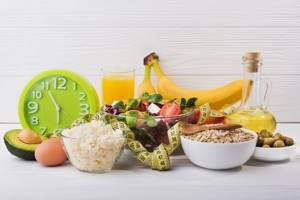
Daily calorie intake for weight loss. Food diary
Below is a step-by-step weight loss plan , which is recommended for every patient in clinics when contacting a nutritionist.

Calories per day should be calculated as follows:
- first, you write down in a notebook everything you eat during the day on normal days (without a diet);
- calculate your usual caloric intake for several days, a week;
- find out what exactly you should give up, which foods are too high in calories, and why your weight increases or does not decrease;
- Gradually reduce your daily calorie intake . First, remove all fatty, floury, and sweet foods. Eliminate smoked meats and pickles, which retain liquid. Calculate your current caloric intake;
- Follow this diet until your weight drops steadily;
- when you notice that the weight has stabilized and measured, reduce the calorie content by 400-500 kcal from the previous values. To lose weight, calories must be reduced.
How to balance your diet. Formula SP
Many people wonder how to balance their diet in order to get the most nutrients from food.
Fats are among the most energy-intensive substances. They contain fatty acids, phospholipids and vitamins. There are animal fats and vegetable fats.
Proteins play the role of foundation. They take part in the synthesis of vitamins, hormones and enzymes.
Carbohydrates are the fuel material that supports all essential functions. Carbohydrates include fiber, which helps digest food.
Vitamins and minerals help the body function properly.
The rules of the joint venture are simple. The volume of protein food entering the body per day is 15%. For every kilogram of a person's weight, there should be 1 g of protein.
The amount of fat entering the body should not exceed 30% of the daily diet. If we translate this into a percentage, we get the following picture:
- up to 10% – saturated acids;
- up to 15% – monounsaturated acids;
- up to 7% – polyunsaturated acids.
Saturated acids are present in large quantities in margarine and butter. Monounsaturated – in oils (corn, sunflower, soybean) and in fish. Polyunsaturated – in olive and peanut oils.
The amount of carbohydrates is 70% of all food consumed per day.
Fiber refers to carbohydrates that are not absorbed by the body. But without it, the normal functioning of the digestive system is disrupted. Foods containing fiber include:
- bread of different types;
- fruits;
- vegetables;
- potato;
- nuts;
- cereals
The joint venture formula will look like this:
DP = 80 g protein + 80 g fat + 400 g carbohydrates.
The daily menu option can be displayed in the table (breakfast, lunch, dinner and 2 snacks):
| Breakfast | The calorie content of breakfast should be no more than 40% of the daily value. |
| Lunch | Should not be more than 100 kcal (proteins, carbohydrates). The best option is cottage cheese with nuts. |
| Dinner | The amount of calories should be 30%. You should eat a hot first course, a side dish of vegetables combined with protein foods, and drink a glass of freshly squeezed juice. |
| Afternoon snack | You can snack on foods containing carbohydrates. Its calorie content should not exceed 150 kcal. It is recommended to drink green tea during the afternoon snack. |
| Dinner | The calorie content of the last meal is 20%. Food should contain vegetable proteins and carbohydrates. |

Structure of a low-calorie diet
Using the products from these tables will help you adjust your diet and independently select products for your daily menu.

The structure of a low-calorie diet should be built as follows:
- In the morning - porridge, fruits, allowed sweets.
- Lunch – liquid hot dishes, protein dishes, vegetables.
- Dinner – protein and some low-calorie vegetables.
- Snacks – low-fat dairy products, fruits and vegetables in small quantities (100-150g).
The closer it gets to the evening, the less caloric the food should be . In the evening, activity usually decreases, so it will no longer be possible to burn a large number of calories and, as a result, they will be deposited in your problem areas.
Prohibited Products

- chips and crackers
- pastas, breads and cereals
- sugar (you will have to drink unsweetened tea and coffee)
- plenty of fruits, vegetables and low-fat dairy products
- bananas and grapes (they contain a lot of fructose, a natural sugar)
- desserts such as cakes, pies and cookies
- cream (for coffee and ice cream)
- frozen meals
- fatty sauces, ketchup, mayonnaise
- juices, compotes and any other sweet drinks
- starchy vegetables (potatoes, sweet potatoes, etc.)
Physical activity on a low-calorie diet
As a complement to a low-calorie diet, it is necessary to include any physical activity in your daily program . This could be fitness, aerobics, cycling, swimming, etc. If you don’t have time for exercise, then:
- walk quickly;
- take the stairs without an elevator;
- overcome long corridors at work by running;
- do muscle exercises while in transport, alternately tensing and relaxing your muscles;
- buy a small ball, and while sitting at your office desk, squeeze it with your feet;
- find time for 15 minutes of morning exercises, getting up a little earlier or doing it in the evenings;
- do exercises while watching TV, combining business with pleasure.
If you wish, you can always find time for exercise by canceling some unimportant and non-urgent matters.
Here is a video about how important physical activity is when eating a low-calorie diet:
Advantages and disadvantages
The diet has the following advantages:
- You can select products as you wish.
- During the diet there is no feeling of hunger.
- The digestive system functions well.
- Large selection of approved products.
- You can create your own menu.
- Available products.
- Easy to prepare dishes.
- A person develops the habit of organized nutrition.
- Excess weight goes away quickly and does not return.
The diet has several disadvantages:
- Not every working person can eat frequently.
- There are contraindications to the diet.
Even more useful information about fractional meals by the hour in this video:
Limit fats and easily digestible carbohydrates
A low-calorie diet is always associated with limiting fats and easily digestible carbohydrates . You should give up all types of fatty foods. Avoid buying and eating the following foods:
- Fatty meat, sausages, frankfurters.
- Duck, goose, offal from them.
- Chicken skin.
- Cooking fat, margarine, lard.
- A large amount of vegetable oils.
- Fatty dairy products, glazed curd cheeses.
You should also avoid easily digestible carbohydrates.:
- Flour products, rolls, pastries, fried dough (pies, pancakes, pancakes, etc.)
- Confectionery (cakes, candies, cakes, cookies, etc.)
- A large number of cereals, porridges with butter, pasta. Porridge can be eaten only in the morning in the amount of 100-150g per serving.
- Large volumes of fruits and berries. We often think that if fruits and berries are low in calories, then we can eat as much of them as we want. But this is absolutely not true. During the season, many people try to fill up on fruit, eating 0.5-1 kg at a time. At the same time, the stomach stretches, and the body requires increasingly larger portions.
- Sweet carbonated drinks that contain about 5-10 tablespoons of sugar per 1 glass of liquid or harmful sweeteners.
How controlling your diet helps you lose weight
Many people do not understand how the correct diet for weight loss by the hour helps eliminate extra pounds. Numerous clinical studies have shown that the body's functioning is partially dependent on eating and sleeping patterns.
If you stick to the right regimen, you simply won’t gain excess weight. Diets often do not bring results because:
- a person eats at night. If you limit yourself in nutrition throughout the day, by the evening you will awaken a strong appetite. A person with weak willpower simply will not be able to curb hunger, as a result of which he will eat before going to bed and have a full stomach. Everything eaten will not have time to be digested and will go into increasing the fat layer. If you eat according to the clock and do not eat enough in the evening, closer to bedtime all the food eaten will be processed;
- slow metabolism. If you eat at the wrong time and constantly snack, there is an increased likelihood of a slowdown in metabolic processes. Doctors assure that a timed diet for weight loss is guaranteed to help normalize metabolic processes, as a result of which, with a calorie deficit, the volume of the thighs will begin to decrease, and the “orange peel” will level out;
- maintaining a sedentary lifestyle. Drawing up an individual schedule of proper nutrition by the hour for weight loss requires adherence to a daily routine. The minimum that you will need to do is exercise in the morning. Experts also strongly recommend taking long walks at least 3 times a week. This will help not only increase muscle tone, but also saturate the cells with oxygen, which is one of the strongest fat burners.
How to control yourself

Unlike most diets, a healthy eating regimen requires some preparation. A person will definitely have to take care of himself and try to eradicate bad habits. In addition, experts advise adhering to the following recommendations:
- it is necessary to first study the information on creating a proper diet;
- you need to write down your standard daily routine on a piece of paper and cross off from the list everything that interferes with the weight loss process;
- It is necessary to keep a list of planned tasks and write a period of time next to each of them. This applies not only to exercise, going to the gym and walking, but also to eating;
- You definitely need to calculate how much time it takes to complete a particular event.
Only after all this can you begin to create an individual daily routine. The recorded plan must be recorded on paper or electronic media. At first, every action must be checked against it.
What other low-calorie diets are there?
Low-calorie diets that are recommended for people who control their weight include the following:
- Japanese diet for two weeks;
- diet 1200 kcal per day;
- diet for the lazy or water diet;
- chocolate diet;
- spicy diet, etc.
Each of the proposed diets has its own characteristics. But each of them has disadvantages.

For example, a chocolate diet involves eating only chocolate and coffee , which in principle cannot be beneficial, since the body does not receive vitamins, proteins, and minerals. A spicy diet is only suitable for those who do not have stomach problems, because abundantly flavoring all dishes with hot pepper can provoke inflammatory processes and lead to gastritis.
What kind of alcohol can you drink for weight loss?
Low-calorie alcoholic drinks with minimal sugar content and low strength are suitable for weight loss. Recommendations for selection:
- Brut (dry sparkling wine) is suitable for champagne.
- The best drink for a diet is dry and semi-dry red wines, which contain a minimum of calories, improve blood circulation, and prevent blood clots.
- Of all types of beer, you can take light beer, with a strength of no more than 5%.
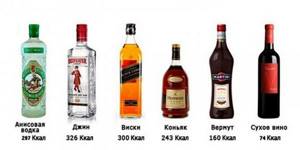
Low calorie alcoholic drinks
The lower the strength of the alcohol, the less sugar it contains. Low calorie alcohol:
| Drink name | Calorie content, kcal/100 ml |
| Dry red wine | 67 |
| Gin and tonic | 88 |
| Dry white wine | 66 |
| Beer 1.8% | 29 |
| Champagne brut | 85 |
| Cocktail "Mojito" | 70 |
| Beer 2.8% | 39 |
| Sweet white wine | 98 |
| Martini "Royal Bianco" | 73 |
| Absinthe | 83 |
| Beer 4.5% | 45 |
| Cocktail "Cosmopolitan" | 100 |
Cons of the diet
But a low-calorie diet, like all others, has its drawbacks . A typical low-calorie diet includes a variety of foods, although they are low in fat and carbohydrates. Therefore, it is considered the most useful and easy to use , suitable for those who do not have large funds to purchase expensive food products. However, many people neglect the simple rules of a low-calorie diet. For example:
- they are too lazy to prepare meat dishes, buying low-fat beef or chicken sausage or frankfurters;
- instead of natural vegetables and fruits, use canned ones;
- knowing that many fruits and vegetables are low in calories, eat them in kilograms;
- They use only those foods that they love more than others, and eat monotonously.
The main disadvantages are:
- Refusal of many favorite dishes, confectionery, sweets, fried and smoked foods, sauces and mayonnaise.
- The need to constantly weigh food and count calories.
- The need to have a constant supply of healthy products to eliminate the possibility of failure.
- It is difficult to give up your usual dishes if you are in a company or your family continues to eat high-calorie dishes.
- Lack of essential vitamins, minerals, antioxidants. Be sure to additionally consume mineral-vitamin complexes, which contain a daily dose of the necessary vitamins and minerals.
If you overcome these difficulties and learn how to properly combine low-calorie foods with each other , then the diet will have no contraindications.
Meal times with proper nutrition
After you have mastered all the rules and purchased the necessary products, you will need to create a schedule where you can schedule proper nutrition hourly:
- Remember that healthy carbohydrates will enter the intestines after 4-6 hours. Therefore, it is better to eat dishes such as cereals, pasta and bread for breakfast so as not to feel hungry longer. Be sure to make your proper breakfast tastier; add fruits, berries, and honey to regular cereals.
- It is advisable to have lunch around 12 o'clock, and the diet should include all types of foods: proteins, fats, carbohydrates. In the middle of the day, be sure to eat the first course and a small lean side dish. Avoid fast food packages, crackers, chips and fast food.
- It is better to have dinner around 5-6 pm with protein foods. It will be digested in the stomach in just 2-3 hours, so it will not disturb your sleep. Prepare lean fish or meat, eat a piece of chicken or a cup of cottage cheese.
Reviews about the diet
Here are some low-calorie diet reviews to help you make your own decision:
Alisa, 34 years old, manager: My childhood years were spent in a constant struggle with excess weight, but my family kept repeating that I didn’t eat enough and prepared me such “delicacies” that it was impossible to refuse. As a result, by the age of 17 I weighed 94 kg. Not a single guy looked in my direction. Then I went to study in another city and settled in a rented apartment with one girl, who taught me to choose low-calorie and healthy foods. Literally in the first three months I lost 12 kg, then in two years another 26! I didn’t recognize myself, and when I finally went home, my family was shocked. Instead of a fat woman, a slender woman stood in front of them. Now I eat only this way, it’s healthy and I like it, and it’s inexpensive!
Arthur, 35 years old, mechanic I lost 15 kg in one year on a low-calorie diet. I made up my own menu, combining, for example, meat with lettuce or cabbage. I don’t like to cook, but that’s the good thing about a low-calorie diet – put the meat in water and cook for yourself. I cook it for 3-4 days and eat it piece by piece. I take it with me to work in the garage, at the buffet I only buy kefir or tea without sugar, and I often take apples with me. And our people at the buffet eat fast food and beer, all fat, with bellies as one. They are surprised when they look at me.
Anya, mother of 2 children, 26 years old After giving birth to my second child, I was simply devastated. I already had a belly, and here... I couldn’t fit into any dress, I didn’t even dream of trousers. She wore some enormous robes. 105-106kg was on the scales. My husband said that if I don’t lose weight, we will be divorced. I was offended by him then, but now I’m glad he said that, otherwise I wouldn’t have lost weight. I pulled myself together out of anger at him, I wanted to prove to him out of spite that I could become slim and then I would leave him myself. So, in the first 4 months I lost 25 kg by eating a low-calorie diet. The menu was 600 kcal per day, it was difficult, but I quickly got used to it, my stomach shrank, and my appetite also disappeared. Now I already weigh 65 kg, I continue to lose weight, I want to weigh 55-57. It was only difficult at the beginning, so anything is possible.
Watch the video about how a guy managed to lose 35 kg in a few months thanks to proper nutrition and calorie counting:
Low-calorie recipes (can be printed on the refrigerator)
Here are some recipes to help you get started on your diet.
Cottage cheese casserole
Take 300g of low-fat cottage cheese, add one raw egg, one chopped apple or pear, or orange, plum, pineapple or apricot, whatever you have. Grease the mold with vegetable oil and spread the curd mixture. Place in the oven.

Fish baked with vegetables
Clean the fish, salt, season with spices, place on a baking sheet, top with onion rings, tomato slices, slices of zucchini, eggplant, and herbs. From vegetables, you can choose what is available. Bake in the oven.
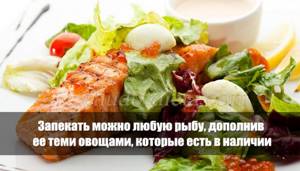
Chicken in molds or chicken muffins
Chop the chicken fillet into small pieces, add one raw egg, spices, salt, pieces of tomatoes and sweet peppers, herbs, place in silicone molds and bake in the oven.

List of foods that are considered low carb

- zucchini
- cauliflower
- curly cabbage
- spinach
- broccoli
- tops
- arugula
- mushrooms
- celery
- tomatoes
- Bell pepper
- olives
- eggplant
- radish
- watercress
- bok choy
- avocado
- strawberries
- fish
- chicken
- turkey
- pork
- roast beef
- eggs
- Oil
- cottage cheese
- full fat greek yogurt
- tofu
Book “Low-calorie desserts”
On our website you can also download the book “Low-calorie desserts” by Alexander Seleznev. He is an excellent pastry chef, as well as a “star guru”. His dishes receive the highest ratings from celebrities. In the book, he compiled a collection of original and at the same time low-calorie desserts that you can treat yourself to on a diet. The book contains many beautiful illustrations that will appeal to every reader. You can download the book “Low-calorie desserts” for free
